Tuning the Model Winds in Perspective of Operational Storm Surge Prediction in the Adriatic Sea
Abstract
1. Introduction
2. Literary Review
3. Materials and Methods
3.1. Materials: Model Wind
3.2. Materials: Scatterometer Wind
3.3. Methods: The Wind Bias Mitigation Procedure
3.4. Methods: Original and Alternative Mathematical Approaches for the Calculation of the Bias Mitigation Factor
- AF1 and AF2—surrogates of the original algorithm: based on the definition of the OF, but with a regularized denominator, preventing the anomalous behavior of OF when . AF1, the first surrogate, uses the model wind speed instead of the scatterometer wind speed as the denominator in Equation (5), while the denominator of the second (AF2) is the mean value of the scatterometer and model wind speed (Equation (6)):In AF1, the wind speed increment is relative to the model wind instead to the scatterometer wind. This choice entails a better definition than OF, as , i.e., it is positively defined unless some of the model wind speeds are equal to zero.In AF2, the increment in wind speed is relative to the average of the two wind speeds at each step . As one can easily see, in such case the mitigation factor is equal to , where , and the result is always and well-defined unless at least one of the is zero;
- Analytical solution (AS): It is determined from the definition of bias-mitigated model wind (Equation (3)):and constraining to zero the relative difference between the scatterometer and the mitigated model wind (primed quantities are the mitigated ones):Substituting the expression of Equation (3) for in Equation (7), we have:and thus:
- Least square regression approach: A vast class of optimal solutions to the bias-mitigation procedure comes from the least square regression approach (LSR). In the following, we consider two classes of solutions; the first is “linear”, the second is “relative”, obtained by minimizing specific functions of the residuals, which depend on the wind speed of the scatterometer and model, and parameter :
- -
- Least square regression of linear type (LLSR and LLSR): a LSR of linear form is used in the minimization of the sum of the squared residuals of the differenced scatterometer minus model determinations, with respect to parameter , which corresponds to to be determined.The first approach considered in this study is the simplest: the function to be minimized is the squared sum of the residuals formed by the scatterometer and the bias-mitigated model wind speeds. Parameter is hidden in the definition of the latter:the solution, in this case, is given by:The second of the linear LSR approaches (LLSR) takes into consideration the dependence of the sea surface wind stress on the squared wind speed [26], as well as the dependence of the surge level on the squared wind speed in theoretical [26] and empirical [27] models. This requirement is formalized in the formula by inserting the squared instead of the linear wind speeds:and the solution is:
- -
- Least square regression of relative form (RLSR and RLSR): it has been suggested that, in cases where relative variations are more significant than absolute variations, a relative form of LSR is more suitable then a direct one [28]. This indication perfectly fits the problem we are facing in our study. Even in the Relative LSR we adopted two minimization approaches: in the first (RLSR), the minimization is performed on the sum of the squared residuals, weighted by the inverse of the scatterometer wind speed:with solution:In the second formulation (RLSR), the wind speeds in the numerator appear squared, while the weights are the same as in the linear case:with solution:
3.5. Methods: Statistical Analysis and Parameters Used in the Comparison
- D1: a historical dataset of 29 Storm Surge Events (SEVs) occurred between 2004 and 2014 in the Adriatic Sea, which triggered high water in the Venice lagoon, with an observed surge of >40 cm. This dataset has been considered here as it was first used by [8] and thus represents a natural test bed for the alternative mathematical approaches that we will introduce later. In our processing, the overlapping SEVs in D1 have been removed;
- D2: a second dataset has been arranged to integrate D1 with more recent SEVs, for a total of 48 cases (observed surge > 40 cm) between 2013 and 2016. In such a period, Venice experienced an unusually high number of high waters. Note that, while in 2004–2014, we count 29 SEVs, i.e., 2.6 SEV per year, in 2013–2016, this figure has risen to 12.0 SEV per year;
- D3: the third dataset is formed by 364 cases of random sea level conditions in the same years as the second (2013–2016) and has been included to test the wind bias mitigation procedure in operational-like conditions, to assess the behavior of the WBM procedure with respect to false positivity. Cases are picked up once every four days so that wind conditions are random and completely unrelated to storm surge occurrence;
- D4: the fourth is formed by the seven SEVs, between 2012 and 2016, the worst predicted by the Tide Forecast and Early Warning Centre of the Venice Municipality (A. Tosoni, 2017—personal communication).
- centered root mean square difference (cRMSD): the cRMSD is the root mean square difference (RMSD) of two series after removing their means;
- standard deviation: standard deviation of each series;
- Person’s linear correlation coefficient: linear correlation of two series;
- bias: difference of the mean values of two series;
- success rate (SR): in this context, it is the percentage of times in which the SEV averages of the mitigated model winds were closer to that of the observed winds compared to the average of the non-mitigated model winds;
4. Results
5. Discussion
6. Conclusions
7. Perspectives
Author Contributions
Funding
Data Availability Statement
Acknowledgments
Conflicts of Interest
References
- Lionello, P.; Cavaleri, L.; Nissen, K.; Pino, C.; Raicich, F.; Ulbrich, U. Severe marine storms in the Northern Adriatic: Characteristics and trends. Phys. Chem. Earth Parts A/B/C 2012, 40–41, 93–105. [Google Scholar] [CrossRef]
- Zecchetto, S.; Umgiesser, G.; Brocchini, M. Hindcast of a storm surge induced by local real wind fields in the Venice Lagoon. Cont. Shelf Res. 1997, 17, 1513–1538. [Google Scholar] [CrossRef]
- Mel, R.; Carniello, L.; D’Alpaos, L. Addressing the effect of the Mo.S.E. barriers closure on wind setup within the Venice lagoon. Estuarine, Coast. Shelf Sci. 2019, 225, 106249. [Google Scholar] [CrossRef]
- Lionello, P.; Barriopedro, D.; Ferrarin, C.; Nicholls, R.J.; Orlić, M.; Raicich, F.; Reale, M.; Umgiesser, G.; Vousdoukas, M.; Zanchettin, D. Extreme floods of Venice: Characteristics, dynamics, past and future evolution. Nat. Hazards Earth Syst. Sci. 2021, 21, 2705–2731. [Google Scholar] [CrossRef]
- Church, J.A.; Clark, P.U.; Cazenave, A.; Gregory, J.M.; Jevrejeva, S.; Levermann, A.; Merrifield, M.A.; Milne, G.A.; Nerem, R.S.; Nunn, P.D.; et al. Sea Level Change. In Climate Change 2013: The Physical Science Basis. Contribution of Working Group I to the Fifth Assessment Report of the Intergovernmental Panel on Climate Change; Stocker, T.F., Qin, D., Plattner, G.K., Tignor, M., Allen, S.K., Boschung, J., Nauels, A., Xia, Y., Bex, V., Midgley, P.M., Eds.; Cambridge University Press: Cambridge, UK; New York, NY, USA, 2013; Chapter 13; pp. 1137–1216. [Google Scholar]
- Verspeek, J.; Stoffelen, A.; Portabella, M.; Bonekamp, H.; Anderson, C.; Saldana, J.F. Validation and Calibration of ASCAT Using CMOD5.n. IEEE Trans. Geosci. Remote Sens. 2010, 48, 386–395. [Google Scholar] [CrossRef]
- De Biasio, F.; Vignudelli, S.; della Valle, A.; Umgiesser, G.; Bajo, M.; Zecchetto, S. Exploiting the potential of satellite microwave remote sensing to hindcast the storm surge in the Gulf of Venice. IEEE J. Sel. Top. Appl. Earth Obs. Remote Sens. 2016, 9, 5089–5105. [Google Scholar] [CrossRef]
- Zecchetto, S.; della Valle, A.; De Biasio, F. Mitigation of ECMWF–scatterometer wind biases in view of storm surge applications in the Adriatic Sea. Adv. Space Res. 2015, 55, 1291–1299. [Google Scholar] [CrossRef]
- Accadia, C.; Zecchetto, S.; Lavagnini, A.; Speranza, A. Comparison of 10-m Wind Forecasts from a Regional Area Model and QuikSCAT Scatterometer Wind Observations over the Mediterranean Sea. Mon. Weather Rev. 2007, 135, 1945–1960. [Google Scholar] [CrossRef]
- Kara, A.B.; Wallcraft, A.J.; Martin, P.J.; Pauley, R.L. Optimizing surface winds using QuikSCAT measurements in the Mediterranean Sea during 2000–2006. J. Mar. Syst. 2009, 78, 119–131. [Google Scholar] [CrossRef]
- Zecchetto, S.; De Biasio, F.; Accadia, C. Scatterometer and ECMWF-derived wind vorticity over the Mediterranean Basin. Q. J. R. Meteorol. Soc. 2013, 139, 674–684. [Google Scholar] [CrossRef]
- Zecchetto, S.; Accadia, C. Diagnostics of T1279 ECMWF analysis winds in the Mediterranean basin by comparison with ASCAT 12.5 km winds. Q. J. R. Meteorol. Soc. 2014, 140, 2506–2514. [Google Scholar] [CrossRef]
- De Chiara, G.; English, S.; Janssen, P.; Bidlot, J.R. ASCAT Ocean Surface Wind Assessment; ECMWF: Reading, UK, 2016. [Google Scholar]
- Zecchetto, S.; De Biasio, F. Wavenumber spectra of the Mediterranean Sea winds derived from the NASA QuikSCAT data. In Proceedings of the IGARSS 2003—2003 IEEE International Geoscience and Remote Sensing Symposium, Toulouse, France, 21–25 July 2003; Volume 3, pp. 1907–1909. [Google Scholar] [CrossRef]
- De Biasio, F.; Bajo, M.; Vignudelli, S.; Umgiesser, G.; Zecchetto, S. Improvements of storm surge forecasting in the Gulf of Venice exploiting the potential of satellite data: The ESA DUE eSurge-Venice project. Eur. J. Remote Sens. 2017, 50, 428–441. [Google Scholar] [CrossRef]
- Bajo, M.; De Biasio, F.; Umgiesser, G.; Vignudelli, S.; Zecchetto, S. Impact of using scatterometer and altimeter data on storm surge forecasting. Ocean Model. 2017, 113, 85–94. [Google Scholar] [CrossRef]
- Byrne, D.; Horsburgh, K.; Zachry, B.; Cipollini, P. Using remotely sensed data to modify wind forcing in operational storm surge forecasting. Nat. Hazards 2017, 89, 275–293. [Google Scholar] [CrossRef]
- JPL. QuikSCAT Level 2B Version 3, Guide document, version 1.0; Jet Propulsion Laboratory: Pasadena, CA, USA, 2013. [Google Scholar]
- OSISAF. ASCAT Wind Product User Manual, version 1.22; Technical Report SAF/OSI/CDOP/KNMI/TEC/MA/126; Eumetsat: Darmstadt, Germany, 2012. [Google Scholar]
- JPL. Oceansat-2 Level 2B User Guide, Guide document, version 1.0; Jet Propulsion Laboratory: Pasadena, CA, USA, 2013. [Google Scholar]
- Liu, W.T.; Katsaros, K.B.; Businger, J.A. Bulk parameterization of air–sea exchange of heat and water vapor including the molecular constraints at the interface. J. Atmos. Sci. 1979, 36, 1722–1735. [Google Scholar] [CrossRef]
- Pineau-Guillou, L.; Ardhuin, F.; Bouin, M.N.; Redelsperger, J.L.; Chapron, B.; Bidlot, J.R.; Quilfen, Y. Strong winds in a coupled wave–atmosphere model during a North Atlantic storm event: Evaluation against observations. Q. J. R. Meteorol. Soc. 2018, 144, 317–332. [Google Scholar] [CrossRef]
- Drobinski, P.; Alpert, P.; Cavicchia, L.; Flaounas, E.; Hochman, A.; Kotroni, V. Strong winds: Observed trends, future projections. In The Mediterranean Region under Climate Change: A Scientific Update; Moatti, J., Thiébault, S., Eds.; IRD Éditions: Marseille, France, 2016; Chapter 1.3.2; pp. 115–122. [Google Scholar] [CrossRef]
- Fore, A.; Stiles, B.; Chau, A.; Williams, B.; Dunbar, R.; Rodriguez, E. Point-Wise Wind Retrieval and Ambiguity Removal Improvements for the QuikSCAT Climatological Data Set. Geosci. Remote Sens. IEEE Trans. 2014, 52, 51–59. [Google Scholar] [CrossRef]
- Hersbach, H. CMOD5.N: A C-Band Geophysical Model Function for Equivalent Neutral Wind; Technical Report Technical Memorandum No. 554; ECMWF: Reading, UK, 2008. [Google Scholar]
- Pugh, D.T. Tides, Surges and Mean Sea Level: A Handbook for Engineers and Scientists; John Wiley and Sons: Chichester, UK, 1987; p. 472. [Google Scholar]
- Silvester, R. Computation of storm surge. In Proceedings of the 12th Conference on Coastal Engineering, Washington, DC, USA, 13–18 September 1970; pp. 1995–2010. [Google Scholar] [CrossRef]
- Tofallis, C. Least Squares Percentage Regression. J. Mod. Appl. Stat. Methods 2008, 7, 526–534. [Google Scholar] [CrossRef]
- Taylor, K.E. Summarizing multiple aspects of model performance in a single diagram. J. Geophys. Res.-A 2001, 106, 7183–7192. [Google Scholar] [CrossRef]
- Chelton, D.; Freilich, M. Scatterometer-based assessment of 10-m wind analyses from the operational ECMWF and NCEP numerical weather prediction models. J. Geophys. Res. 2005, 133, 409–429. [Google Scholar] [CrossRef]
- Yamartino, A. A comparison of several “single-pass” estimators of the standard deviation of wind direction. J. Climate Appl. Meteor. 1984, 23, 1362–1366. [Google Scholar] [CrossRef]
- Weber, R.O. Estimators for the Standard Deviation of Horizontal Wind Direction. J. Appl. Meteorol. 1997, 36, 1403–1415. [Google Scholar] [CrossRef]
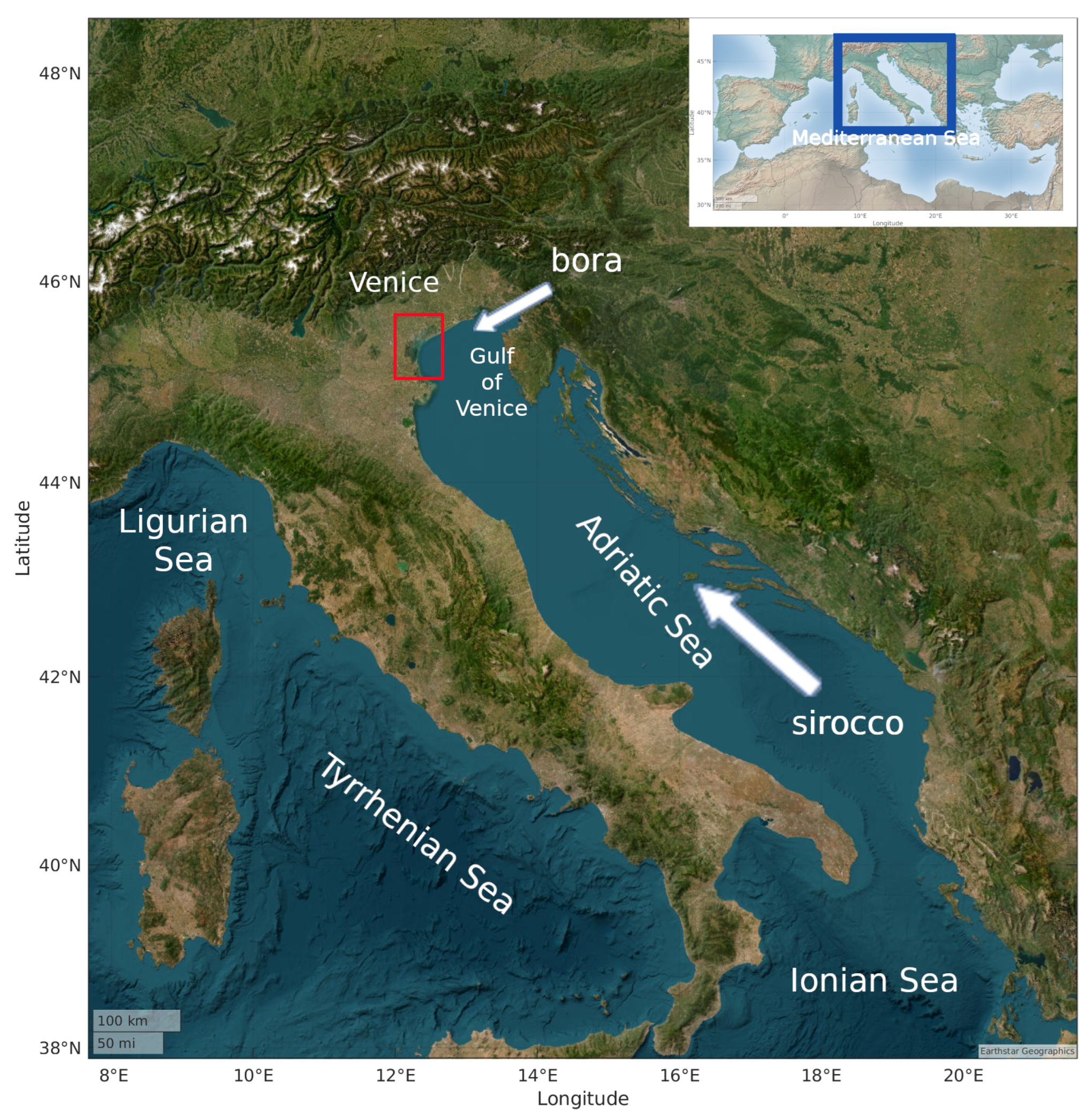
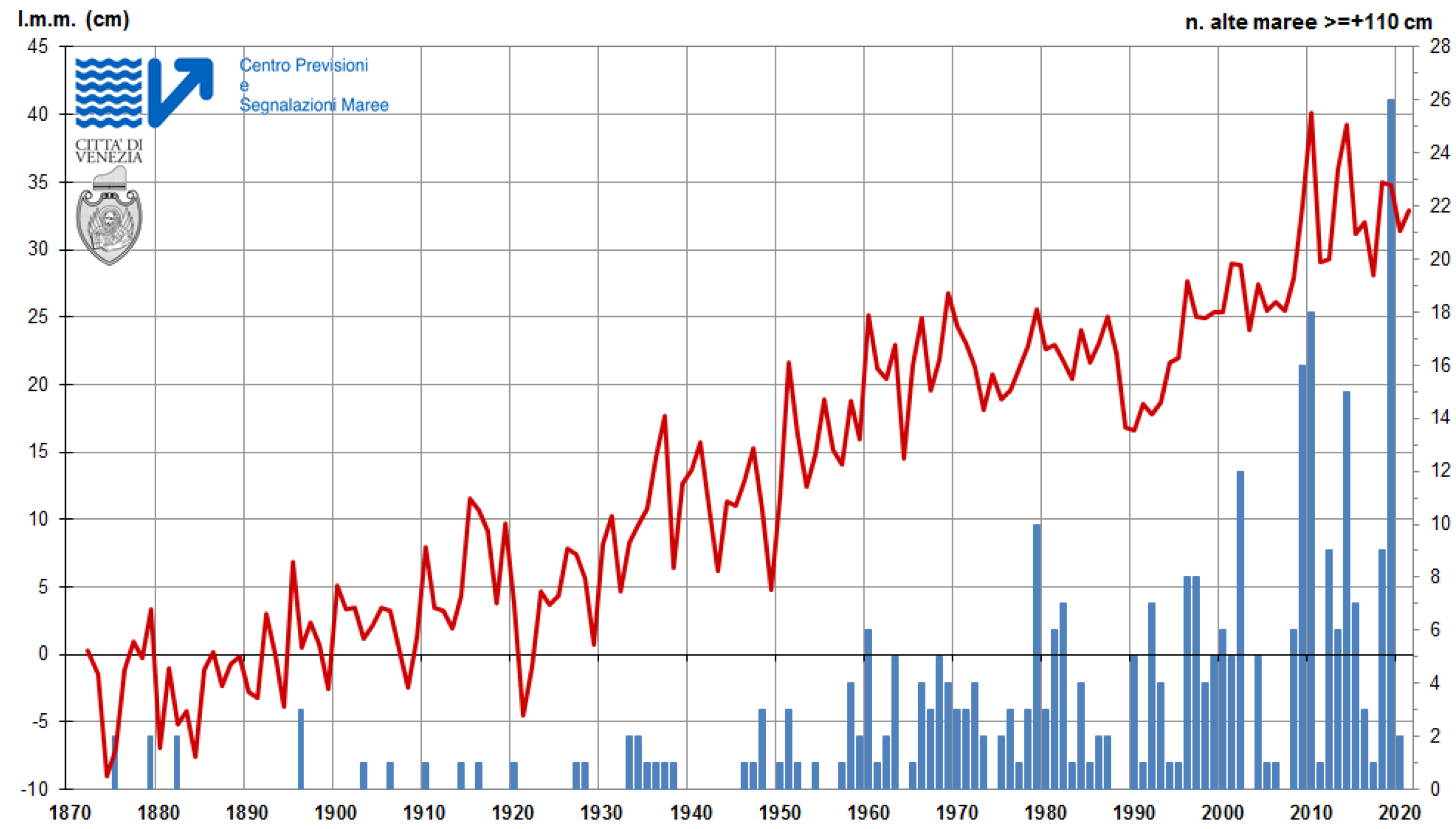
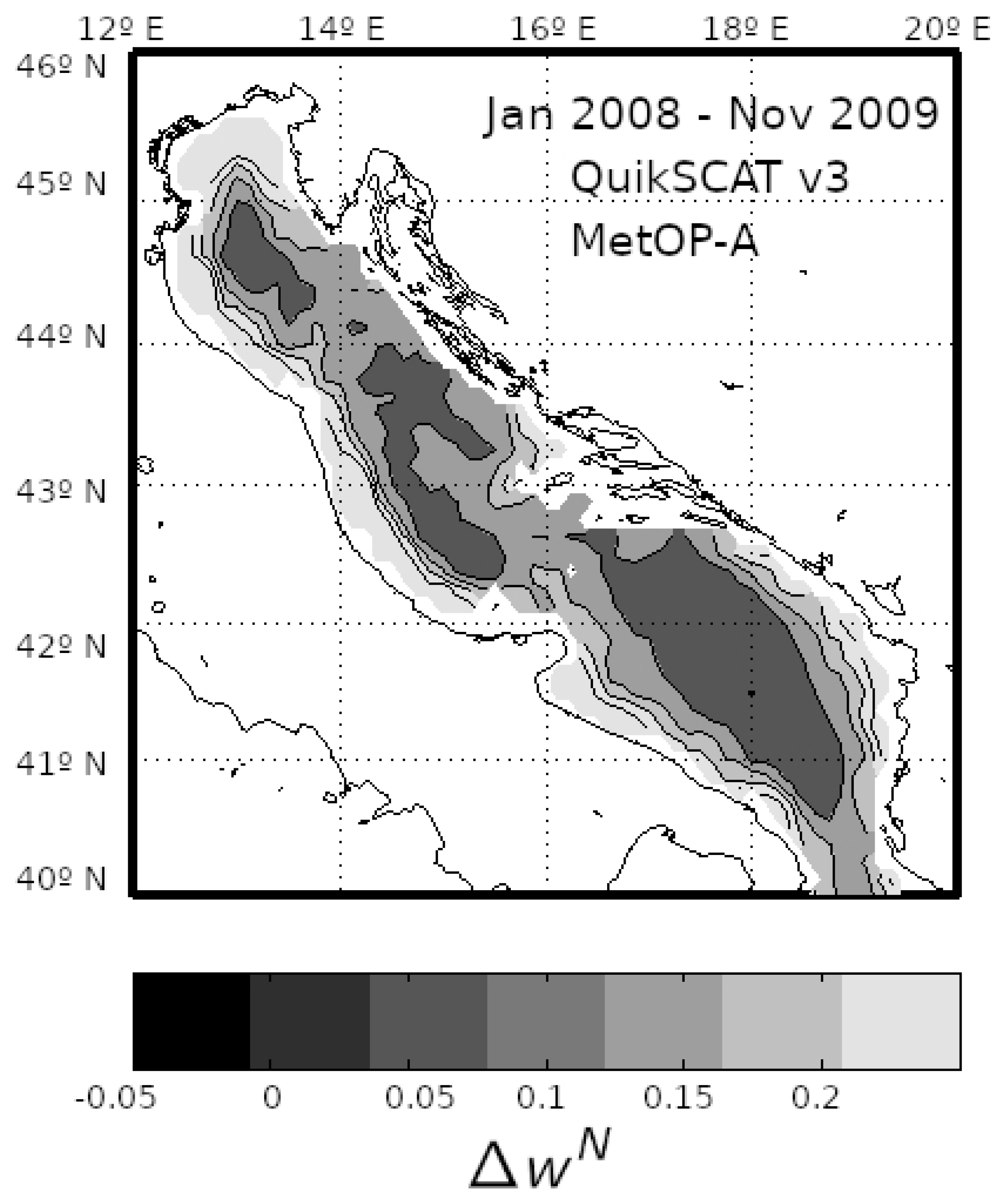

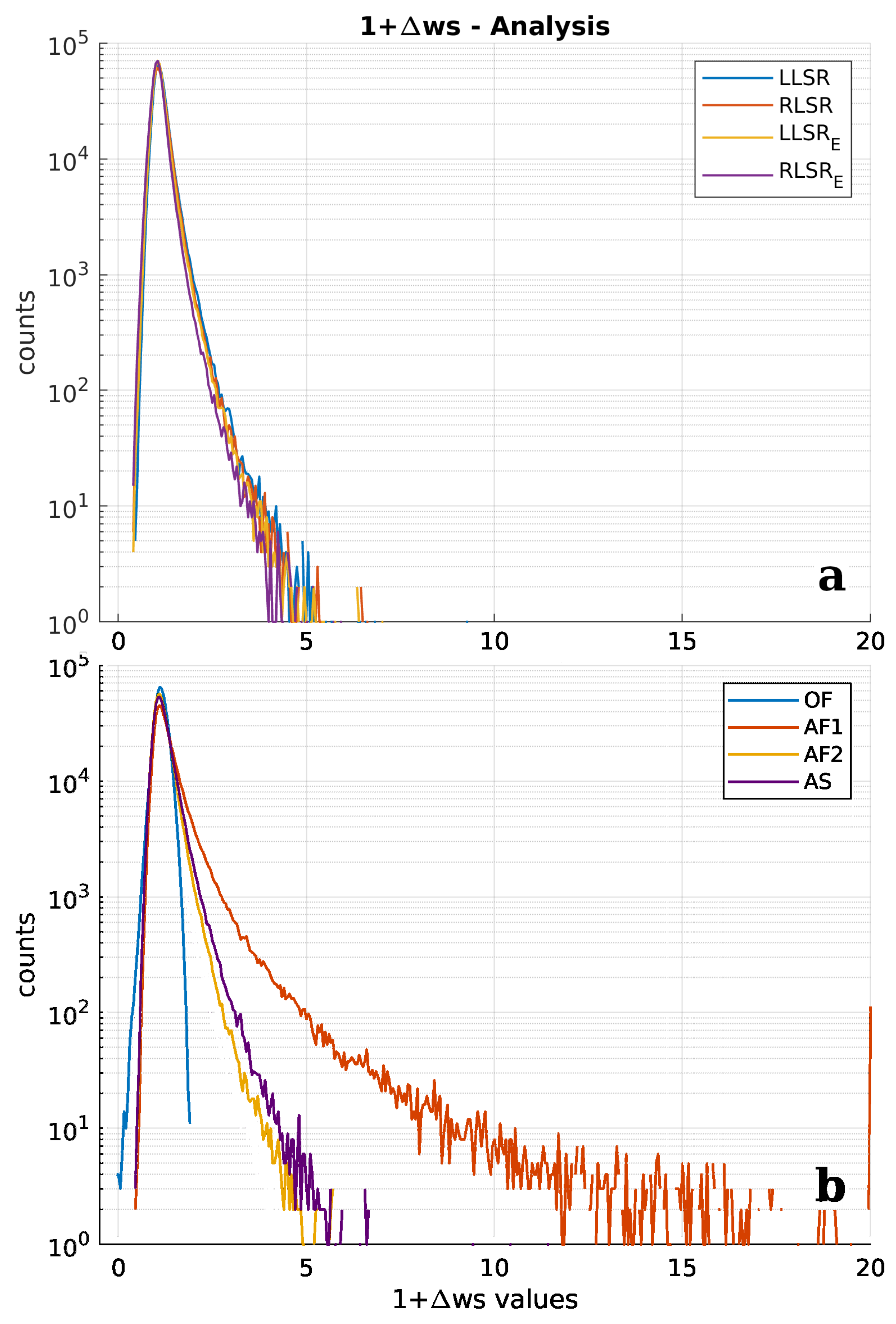

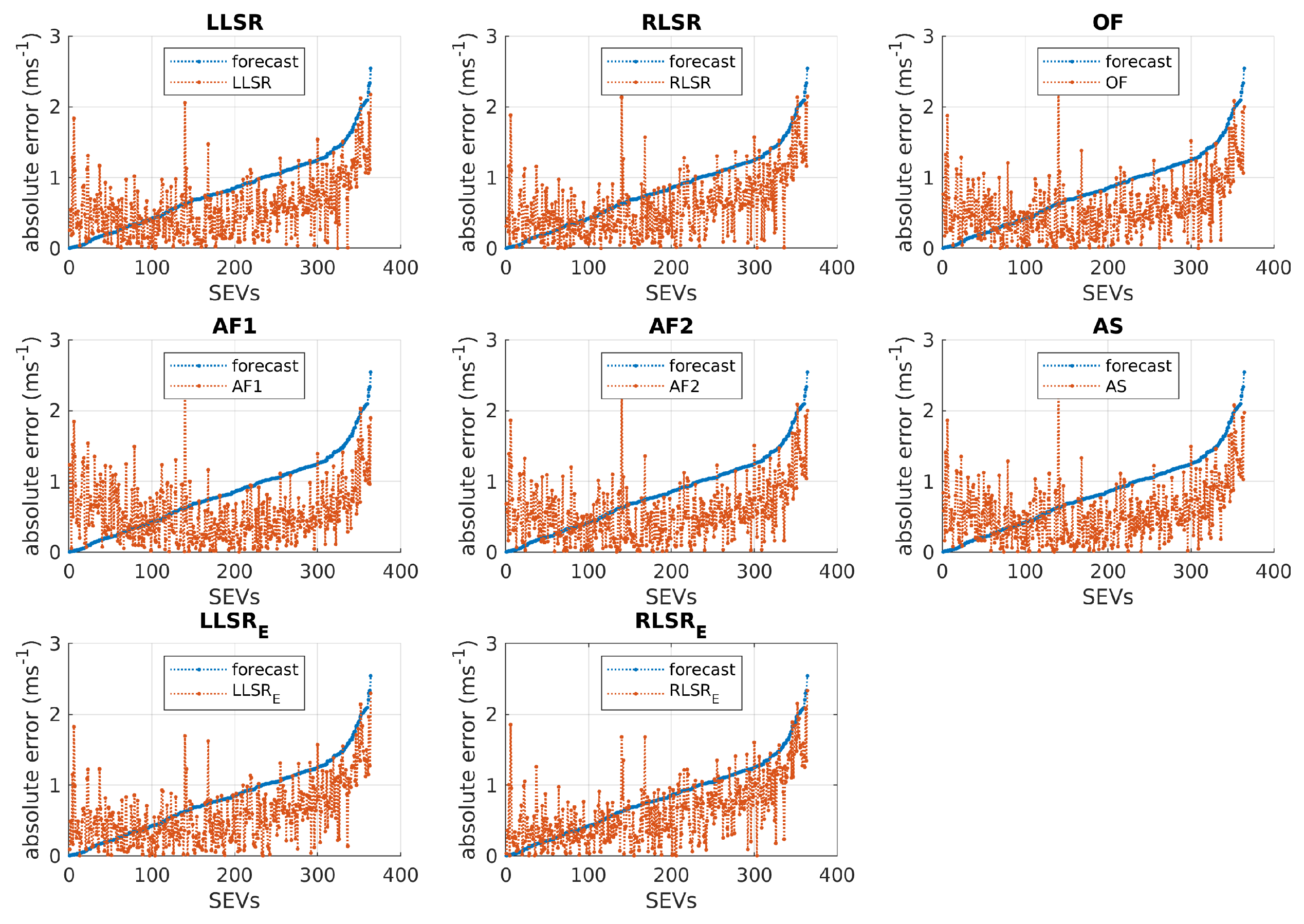
| Model | Mean | Std. Dev. | Median | Skewness | Kurtosis |
|---|---|---|---|---|---|
| 1.15 | 0.25 | 1.11 | 3.17 | 36.79 | |
| 1.12 | 0.25 | 1.09 | 2.71 | 31.28 | |
| 1.12 | 0.23 | 1.09 | 3.01 | 34.97 | |
| 1.08 | 0.22 | 1.06 | 2.75 | 32.90 | |
| 1.13 | 0.18 | 1.13 | −0.01 | 3.71 | |
| 1.41 | 1.06 | 1.22 | 61.87 | 9531.17 | |
| 1.19 | 0.27 | 1.14 | 2.61 | 26.16 | |
| 1.21 | 0.31 | 1.15 | 3.05 | 32.90 |
| Dataset | # | SF | LLSR | RLSR | OF | AF1 | AF2 | AS | LLSR | RLSR |
|---|---|---|---|---|---|---|---|---|---|---|
| D1 | 29 | 0.95 | 0.11 | 0.21 | 0.04 | −0.21 | −0.01 | −0.03 | 0.24 | 0.38 |
| D2 | 48 | 0.97 | 0.16 | 0.30 | 0.10 | −0.15 | 0.06 | 0.03 | 0.27 | 0.45 |
| D3 | 364 | 0.84 | 0.24 | 0.34 | 0.19 | −0.02 | 0.16 | 0.13 | 0.33 | 0.46 |
| D4 | 7 | 0.84 | −0.22 | −0.08 | −0.28 | −0.50 | −0.32 | −0.35 | −0.08 | 0.12 |
| Dataset | # | SF | LLSR | RLSR | OF | AF1 | AF2 | AS | LLSR | RLSR |
|---|---|---|---|---|---|---|---|---|---|---|
| D1 | 29 | 1.00 | 0.60 | 0.63 | 0.60 | 0.67 | 0.61 | 0.61 | 0.61 | 0.68 |
| D2 | 48 | 0.91 | 0.54 | 0.59 | 0.56 | 0.61 | 0.57 | 0.57 | 0.53 | 0.59 |
| D3 | 364 | 0.82 | 0.56 | 0.59 | 0.56 | 0.54 | 0.55 | 0.55 | 0.58 | 0.63 |
| D4 | 7 | 0.78 | 0.39 | 0.37 | 0.43 | 0.51 | 0.43 | 0.43 | 0.38 | 0.37 |
| Dataset | # | LLSR | RLSR | OF | AF1 | AF2 | AS | LLSR | RLSR |
|---|---|---|---|---|---|---|---|---|---|
| D1 | 29 | 79 | 72 | 72 | 76 | 76 | 76 | 79 | 76 |
| D2 | 48 | 79 | 73 | 73 | 71 | 75 | 75 | 81 | 75 |
| D3 | 364 | 71 | 71 | 73 | 71 | 73 | 73 | 73 | 70 |
| D4 | 7 | 86 | 71 | 86 | 57 | 86 | 86 | 100 | 86 |
| LLSR | RLSR | OF | AF1 | AF2 | AS | LLSR | RLSR | |
|---|---|---|---|---|---|---|---|---|
| BIAS | 0.22 | 0.32 | 0.16 | −0.05 | 0.13 | 0.10 | 0.31 | 0.45 |
| SR | 72.61 | 71.28 | 73.14 | 71.10 | 73.61 | 73.61 | 74.67 | 71.17 |
| LLSR | RLSR | OF | AF1 | AF2 | AS | LLSR | RLSR | |
|---|---|---|---|---|---|---|---|---|
| BIAS | 0.11 | 0.24 | 0.05 | −0.20 | 0.00 | −0.02 | 0.23 | 0.40 |
| SR | 79.58 | 72.49 | 73.74 | 71.56 | 76.26 | 76.26 | 81.89 | 76.26 |
Disclaimer/Publisher’s Note: The statements, opinions and data contained in all publications are solely those of the individual author(s) and contributor(s) and not of MDPI and/or the editor(s). MDPI and/or the editor(s) disclaim responsibility for any injury to people or property resulting from any ideas, methods, instructions or products referred to in the content. |
© 2023 by the authors. Licensee MDPI, Basel, Switzerland. This article is an open access article distributed under the terms and conditions of the Creative Commons Attribution (CC BY) license (https://creativecommons.org/licenses/by/4.0/).
Share and Cite
De Biasio, F.; Zecchetto, S. Tuning the Model Winds in Perspective of Operational Storm Surge Prediction in the Adriatic Sea. J. Mar. Sci. Eng. 2023, 11, 544. https://doi.org/10.3390/jmse11030544
De Biasio F, Zecchetto S. Tuning the Model Winds in Perspective of Operational Storm Surge Prediction in the Adriatic Sea. Journal of Marine Science and Engineering. 2023; 11(3):544. https://doi.org/10.3390/jmse11030544
Chicago/Turabian StyleDe Biasio, Francesco, and Stefano Zecchetto. 2023. "Tuning the Model Winds in Perspective of Operational Storm Surge Prediction in the Adriatic Sea" Journal of Marine Science and Engineering 11, no. 3: 544. https://doi.org/10.3390/jmse11030544
APA StyleDe Biasio, F., & Zecchetto, S. (2023). Tuning the Model Winds in Perspective of Operational Storm Surge Prediction in the Adriatic Sea. Journal of Marine Science and Engineering, 11(3), 544. https://doi.org/10.3390/jmse11030544







